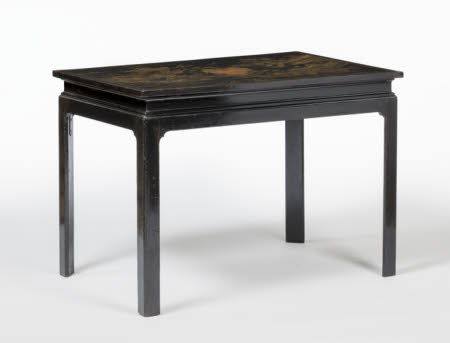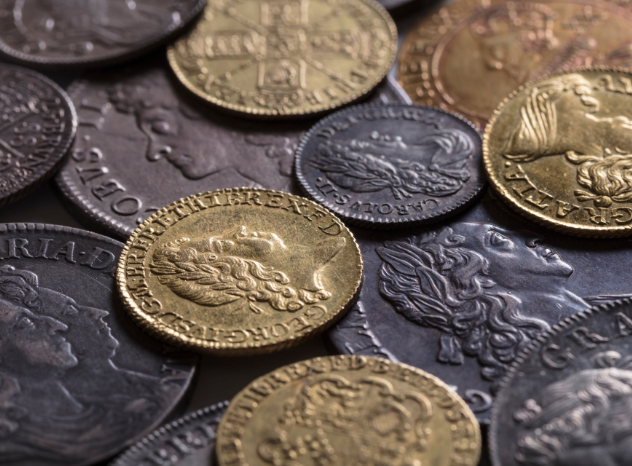Osterley Park's Chinese Export lacquer armorial table - circa 1715-20
Category
Furniture
Date
circa 1715 - 1720
Materials
Top: lacquer, substrate, softwood, gilt Base: oak, softwood, paint
Measurements
75 x 107 x 70 cm
Place of origin
Guangzhou
Order this imageCollection
Osterley Park and House, London
NT 773362
Summary
A lacquered table-top, Chinese Export, probably Guangzhou (Canton), circa 1715-20, the base japanned, English, circa 1715-30. The property of the Earldom of Jersey Trust. Part of a larger group of sixteen pieces of armorial Chinese Export furniture at Osterley, comprising ten hall chairs [NT 771891.1.1-.6 owned by the National Trust; NT 773356.1-..4 the property of the Earldom of Jersey Trust]; a screen [NT 771891.2]; a dressing or toilet box [NT 771891.3], a single chest on later stand [NT 771891.4] and a pair of chests on later stands [NT 771891.5.1 & .5.2]. The top of black lacquer atop substrate and softwood. Centred by the coat of arms granted to Sir Francis Child (1642-1713) in 1700, 'gules, a chevron engrailed ermine between three eagles close each gorged with a ducal coronet or', before a foliate mantling, and topped by the crest of Child, 'on a Rock proper an eagle rising argent holding in the beak an adder proper', on a torse. Surrounded by a landscape of mountainous islands with scattered trees. One island with a pavilion and a bridge. The whole with areas of loss and overpainting. The original border - of repeated splayed elongated leaves forming chevrons, between the leaves a delicate stalk or sprig of stylised foliage, all within gold lines - largely obscured. The base of japanned oak and softwood, and with sunken frieze. The legs with moulded outer corners and chamfered on the inside. Small 'peaked' spandrels between the legs and the frieze. Later metal braces to the table's frame.
Full description
Lacquered objects decorated with a family’s coat of arms were exclusively the preserve of early 18th century England’s richest men, the millionaires who amassed spectacular fortunes from trade, speculation and investment in emerging markets, and the aristocrats who knew them or were their clients. Made in Guangzhou (Canton) in China, specifically for export, lacquered armorial furniture was only available via the East India Company, the chartered British concern with a monopoly on trade with China. English families commissioned a range of objects bearing their arms [1] – porcelain, textiles and different types of furniture – but remarkably, Osterley is the only place where such a large and diverse group has survived together, in the house of the family for which it was made. That sixteen pieces of armorial furniture have remained together, protected in law as heirlooms, is a measure of their rarity and value, and of the esteem in which they were held.[2] Lacquer is a decorative technique which was perfected by Japanese and Chinese artists, involving the building up of layers – on a timber or other substrate – of the sap of the 'Rhus vernicflua' tree. The lustrous surface which results provides the perfect background for decoration in gilt and colours. By 1720, articles of lacquer for export were being made in Guangzhou and were largely the preserve of the private trade in which East India Company captains, investors and directors were authorised to engage, alongside carrying out the official trade of the Company. Captains, crew members and overseers called ‘supercargoes’ were allowed to reserve a portion of the ships’ tonnage for their own goods, or goods which they had been commissioned to buy. Families who commissioned goods from China bearing a coat of arms had first to send a tracing of that coat to China. This was not the only means by which the influence of English consumers was brought to bear on the form and decoration of export wares, particularly where furniture was concerned. As early as 1702, when the London Company of ‘Joyners’ petitioned for the importation of Asian lacquer – because it threatened their own livelihoods – to cease, their complaint was not that Chinese furniture was being brought into England, but that Chinese furniture made after English models was being brought into England. Amongst the goods imported from China ‘within these Four Years’ were ‘six thousand five hundred eighty two Tea-Tables’ and ‘Six hundred fifty five Tops for Stands’. The top of the table at Osterley falls into the latter class, probably being imported as a board, its base made and japanned – to imitate lacquer – on its arrival in England.[3] Having a Chinese top and an English base, this table is a bicultural amalgam, the product of a complex network of trade and exchange of influences. Very few (if any) armorial tables like it survive. The Tower family of London and Huntsmoor Park, Buckinghamshire, ordered a ‘Square Table’ as part of a larger order of armorial furniture and porcelain sometime between 1728 and 1730[4], but its whereabouts are unknown. In her will, Martha Page (d. 1729), the widow of Sir Gregory Page (d. 1720), bequeathed a ‘square Japan table / with the coat of arms’.[5] This is also apparently lost, although two sets of chairs, and a screen, survive bearing the Page coat of arms.[6] Tables like these – if more of them were made – may have influenced English fashions, resulting in English-made tables decorated with coats of arms, like the example made in 1726 at Erdigg.[7] When exactly this table was commissioned, and by whom, it is difficult to say precisely. It is possible, of course, that the surviving armorial furniture at Osterley was the product of several different commissions, as the pieces are of varying quality, and their decoration is clearly not the product of the same hand. The chests and chairs – with decoration confined to the arms and a simple border of leafy chevrons and sprigs – are more restrained, for instance, than this table or the dressing box or casket, which are highly decorated with pictorial landscapes and figures. Francis Child I (d. 1713) and his three sons were all heavily involved in the East India Company. Francis I served as a Director and sat on various committees. His eldest son, Robert Child (d. 1721), followed suit and was elected Chairman in 1715, the same year he was knighted by George I. Francis Child II (1684-1740) and Samuel Child (1693-1752) both also served as Directors, and Samuel held a large number of EIC stocks, and co-owned the EIC chartered ship the Northampton.[8] It is tempting to think that Robert Child commissioned this armorial furniture to commemorate the dual honours of his knighthood and his Chairmanship of the East India Company. Several ‘japanned tables’ were at Osterley when the contents were inventoried in 1782. This table may be the ‘japanned table’ listed alongside eight of the lacquered armorial chairs in the Vestibule Basement Story.[9] Megan Wheeler, October 2019 [1] See, for instance, the will of Martha Page (d. 1729), the widow of Sir Gregory Page (d. 1720), which records a ‘square Japan table / with the coat of arms’ as well as ‘1 paire small [mugges] with armes’ (see National Archives, PROB 11/628/300). [2] A seventeenth piece, also bearing the arms of Child, and probably a pair to the single small chest now in the Gallery at Osterley (NT 771891.4) was sold Sotheby’s, 3 July 1997, Lot 16. The existence of this chest makes it possible that the group was once larger. [3] Kyoungjin Bae, 'Joints of Utility, Crafts of Knowledge: The Material Culture of the Sino-British Furniture Trade during the Long Eighteenth Century' (PhD Thesis, Columbia University, 2016), pp. 23-4. [4] See P. Ferguson, 'Chinese Armorial Wares for James Brydges, 1st Duke of Chandos: Self-Fashioning or Artifice?' (Transactions of the Oriental Ceramic Society, vol. 82, 2017-18, pp.37-47), 37. [5] National Archives, PROB 11/628/300. [6] The first set, very similar to the lacquered chairs at Osterley, dates from circa 1714-20, see A. Bowett, 'Early Georgian Furniture 1715-40' (2009), pp. 154-5 and Fig. 4:16. The second set, of rosewood inlaid with mother-of-pearl are in the Soane Museum (see H. Dorey, ‘A Catalogue of Furniture in Sir John Soane’s Museum’ in Furniture History XLIV (2008), 47-50. [7] NT 1146972. [8] Y. Sharma & P. Davies, ‘A jaghire without a crime’: The East India Company and the Indian Ocean material world at Osterley, 1700-1800’ in E'ast India Company at Home, 1757-1857', eds. M. Finn & K. Smith (2018), p. 91. [9] M. Tomlin, ‘The 1782 Inventory of Osterley Park’ in 'Furniture History' XXII (1986), p. 123.
Provenance
Almost certainly acquired by the Child family of Osterley and London between 1715 and 1720. Thence by descent, and on loan to the National Trust from the Earldom of Jersey Trust.
Marks and inscriptions
Underside of top: The Earl of Jersey
References
National Archives, PROB 11/628/300 Bae, K (2016), Joints of Utility, Crafts of Knowledge: The Material Culture of the Sino-British Furniture Trade during the Long Eighteenth Century (PhD Thesis, Columbia University, 2016), pp.23-4 Ferguson, P (2017), 'Chinese Armorial Wares for James Brydges, 1st Duke of Chandos: Self-fashioning or Artifice?' (Lecture given by Patricia E. Ferguson, 10 October 2017), 1 Dorey, H (2008): 'A Catalogue of Furniture in Sir John Soane's Museum' in Furniture History XLIV (2008), 47-50 Sharma, Y & Davies, P. (2018), 'A jaghire without a crime': The East India Company and the Indian Ocean material world at Osterley, 1700=1800', in East India Company at Home, 1757-1857, eds. M. Finn & K. Smith (2018), 91 Tomlin, 1986: Maurice Tomlin. “The 1782 inventory of Osterley Park.” Furniture History 22 (1986): pp.107-134., 123


